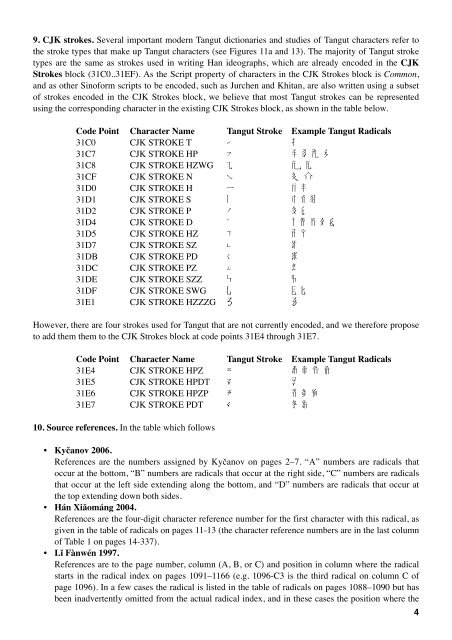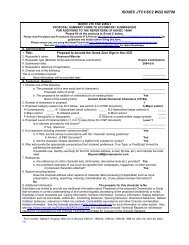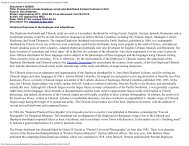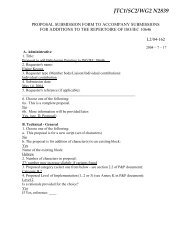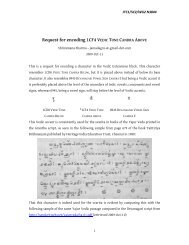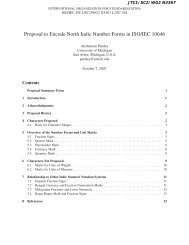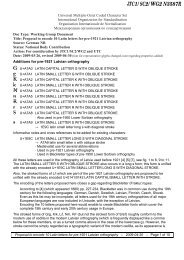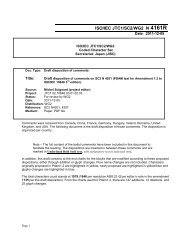Proposal to encode Tangut Radicals and CJK Strokes in the UCS
Proposal to encode Tangut Radicals and CJK Strokes in the UCS
Proposal to encode Tangut Radicals and CJK Strokes in the UCS
You also want an ePaper? Increase the reach of your titles
YUMPU automatically turns print PDFs into web optimized ePapers that Google loves.
9. <strong>CJK</strong> strokes. Several important modern <strong>Tangut</strong> dictionaries <strong>and</strong> studies of <strong>Tangut</strong> characters refer <strong>to</strong><br />
<strong>the</strong> stroke types that make up <strong>Tangut</strong> characters (see Figures 11a <strong>and</strong> 13). The majority of <strong>Tangut</strong> stroke<br />
types are <strong>the</strong> same as strokes used <strong>in</strong> writ<strong>in</strong>g Han ideographs, which are already <strong>encode</strong>d <strong>in</strong> <strong>the</strong> <strong>CJK</strong><br />
<strong>Strokes</strong> block (31C0..31EF). As <strong>the</strong> Script property of characters <strong>in</strong> <strong>the</strong> <strong>CJK</strong> <strong>Strokes</strong> block is Common,<br />
<strong>and</strong> as o<strong>the</strong>r S<strong>in</strong>oform scripts <strong>to</strong> be <strong>encode</strong>d, such as Jurchen <strong>and</strong> Khitan, are also written us<strong>in</strong>g a subset<br />
of strokes <strong>encode</strong>d <strong>in</strong> <strong>the</strong> <strong>CJK</strong> <strong>Strokes</strong> block, we believe that most <strong>Tangut</strong> strokes can be represented<br />
us<strong>in</strong>g <strong>the</strong> correspond<strong>in</strong>g character <strong>in</strong> <strong>the</strong> exist<strong>in</strong>g <strong>CJK</strong> <strong>Strokes</strong> block, as shown <strong>in</strong> <strong>the</strong> table below.<br />
Code Po<strong>in</strong>t Character Name <strong>Tangut</strong> Stroke Example <strong>Tangut</strong> <strong>Radicals</strong><br />
31C0 <strong>CJK</strong> STROKE T ㇀ <br />
31C7 <strong>CJK</strong> STROKE HP ㇇ <br />
31C8 <strong>CJK</strong> STROKE HZWG ㇈ <br />
31CF <strong>CJK</strong> STROKE N ㇏ <br />
31D0 <strong>CJK</strong> STROKE H ㇐ <br />
31D1 <strong>CJK</strong> STROKE S ㇑ <br />
31D2 <strong>CJK</strong> STROKE P ㇒ <br />
31D4 <strong>CJK</strong> STROKE D ㇔ <br />
31D5 <strong>CJK</strong> STROKE HZ ㇕ <br />
31D7 <strong>CJK</strong> STROKE SZ ㇗ <br />
31DB <strong>CJK</strong> STROKE PD ㇛ <br />
31DC <strong>CJK</strong> STROKE PZ ㇜ <br />
31DE <strong>CJK</strong> STROKE SZZ ㇞ <br />
31DF <strong>CJK</strong> STROKE SWG ㇟ <br />
31E1 <strong>CJK</strong> STROKE HZZZG ㇡ <br />
However, <strong>the</strong>re are four strokes used for <strong>Tangut</strong> that are not currently <strong>encode</strong>d, <strong>and</strong> we <strong>the</strong>refore propose<br />
<strong>to</strong> add <strong>the</strong>m <strong>the</strong>m <strong>to</strong> <strong>the</strong> <strong>CJK</strong> <strong>Strokes</strong> block at code po<strong>in</strong>ts 31E4 through 31E7.<br />
Code Po<strong>in</strong>t Character Name <strong>Tangut</strong> Stroke Example <strong>Tangut</strong> <strong>Radicals</strong><br />
31E4 <strong>CJK</strong> STROKE HPZ <br />
31E5 <strong>CJK</strong> STROKE HPDT <br />
31E6 <strong>CJK</strong> STROKE HPZP <br />
31E7 <strong>CJK</strong> STROKE PDT <br />
10. Source references. In <strong>the</strong> table which follows<br />
• Kyčanov 2006.<br />
References are <strong>the</strong> numbers assigned by Kyčanov on pages 2–7. “A” numbers are radicals that<br />
occur at <strong>the</strong> bot<strong>to</strong>m, “B” numbers are radicals that occur at <strong>the</strong> right side, “C” numbers are radicals<br />
that occur at <strong>the</strong> left side extend<strong>in</strong>g along <strong>the</strong> bot<strong>to</strong>m, <strong>and</strong> “D” numbers are radicals that occur at<br />
<strong>the</strong> <strong>to</strong>p extend<strong>in</strong>g down both sides.<br />
• Hán Xiǎománg 2004.<br />
References are <strong>the</strong> four-digit character reference number for <strong>the</strong> first character with this radical, as<br />
given <strong>in</strong> <strong>the</strong> table of radicals on pages 11-13 (<strong>the</strong> character reference numbers are <strong>in</strong> <strong>the</strong> last column<br />
of Table 1 on pages 14-337).<br />
• Lǐ Fànwén 1997.<br />
References are <strong>to</strong> <strong>the</strong> page number, column (A, B, or C) <strong>and</strong> position <strong>in</strong> column where <strong>the</strong> radical<br />
starts <strong>in</strong> <strong>the</strong> radical <strong>in</strong>dex on pages 1091–1166 (e.g. 1096-C3 is <strong>the</strong> third radical on column C of<br />
page 1096). In a few cases <strong>the</strong> radical is listed <strong>in</strong> <strong>the</strong> table of radicals on pages 1088–1090 but has<br />
been <strong>in</strong>advertently omitted from <strong>the</strong> actual radical <strong>in</strong>dex, <strong>and</strong> <strong>in</strong> <strong>the</strong>se cases <strong>the</strong> position where <strong>the</strong><br />
4


